Quick response (QR) codes have experienced rapid growth in recent years, largely driven by their convenience, safety, and ability to facilitate a range of practical applications, from contactless payments to website access, and more.
With ample use cases for these matrix barcodes, recent projections indicate that they’ll become a much bigger part of our lives in the future. With this in mind, it’s about time we learned more about this innovative technology.
To help, we’ve compiled this list of 47 QR code facts, statistics, & trends in 2025. Our article covers everything you need to know about QR codes, including their utility, popularity, and potential pitfalls.
How Do QR Codes Work?
A QR code is a two-dimensional barcode matrix that can contain a variety of information. Files, text, images, and URLs can be embedded in QR codes and accessed when the object is scanned using a specialized reader.
QR codes (also known as smart objects) can be used for the same purposes as barcodes, but also have a great deal more functionality. While standard horizontal barcodes store less than 100 characters, the addition of a second, vertical dimension in QR codes allows them to store more than 250 times this amount.

The most common way to access the data stored in these smart objects is by using a smartphone. All it takes is scanning the QR code with your device’s camera to capture its unique pattern. This pattern is then analyzed and decoded, and the data is either downloaded automatically or displayed as a URL.
Although they’re most commonly read using a smartphone – most modern devices’ native camera apps have QR code-reading functionality – they can also be scanned with dedicated optical scanners. These devices are usually found in stores as well as at event venues and airports, where they can be used to collect payments or verify ticket information.
A Brief History of QR Codes

Quick response codes were invented in 1994 by a team of engineers at Denso Wave, a Japanese company specializing in the production of automatic identification devices (i.e. barcode and QR scanners).
The smart objects were created to improve on barcodes, which could only contain limited amounts of data. They were initially designed for use in the automobile manufacturing industry for keeping track of car parts, but their utility outside of the automotive sector quickly became apparent.
In 2002, the very first mobile phone with a built-in QR scanner (the SHARP-manufactured J-SH09) was released in Japan. The QR scanner was a novelty at the time, as using mobile phones to access the internet was only starting to gain traction.
Nearly a decade later, the rollout of 4G cellular networks made internet browsing on cellphones much faster and more consumer-friendly. This enabled users to interact with QR-embedded content using smartphones.
The first major boost for QR codes in the US came in 2010 when consumer electronics retailer Best Buy started using the objects across its stores to provide shoppers with easy access to information about its products.
In 2011, Android delivered QR Droid, a QR scanner app that uses the phone’s camera to decode these objects and redirect users to content. Some of the other popular apps released that year include QR Reader (also released for iOS) and QR BARCODE SCANNER.
Other major QR code developments came in 2014. The most important was the release of Frame QR codes, which allowed businesses and individuals to customize the codes they generated with visual components like brand logos.
As the utility of QR codes for storing information became evident, airlines started using them for boarding passes. Between 2015 and 2019, the number of boarding passes downloaded onto mobile phones doubled from 0.75 to 1.5 billion.
The biggest jump in QR code usage, however, came between 2020 and 2021. When COVID-19 hit and social distancing became a priority for consumers, businesses had to move toward contactless methods of interacting with customers. The QR code was the perfect solution and worldwide usage of QR codes for payments increased by nearly 50% during that period.
Section 1: General Overview of QR Code Use
With their ability to provide access to websites, enable mobile payments, and retrieve data, there’s been a sharp rise in the use and distribution of QR codes. Below are some of the most important general statistics on the usage of these scannable matrices.
#1 The QR Payment Market Is Worth Billions of Dollars

The QR payment market’s value reached close to $10 billion in 2022. According to market forecasts, this number is expected to hit $33.13 billion by 2030.
The continued growth of QR code usage is driven by the increasing shift toward contactless payments in developed regions, as well as improvements in financial inclusion and accessible banking in developing nations.
#2 Global QR Payment Usage Has Risen Rapidly

Between September 2020 and April 2021, the percentage of surveyed consumers who had used a QR code as a payment method rose from 35.53% to 83%. This can largely be explained by the COVID-19 pandemic and the resulting turn toward contactless payment methods.
Other possible reasons for this trend are the increasing utility of QR codes and growing internet penetration rates around the world. As the native camera applications on most smartphones now come with built-in QR code scanners, consumers need only their devices and an internet connection to use this technology.
#3 QR Code Scans Quadrupled in 2022

The usage of QR codes grew rapidly in 2022. QR Tiger, a popular QR code generation solution, has revealed that the number of scans for user-generated codes was four times higher than in 2021.
These smart objects have been prominent in a number of industries, such as air travel and events, since the mid-2010s. While COVID-19 helped them break into the mainstream, their projected growth shows no signs of slowing post pandemic.
#4 What Are QR Codes Used For?

QR codes are most commonly used to access URLs. The objects allow businesses to redirect users directly to payment screens or marketing content.
They’re also showing promising growth in other areas, such as social media and mobile app store links. Many social media platforms have rolled out personalized QR codes for user profiles in recent years.
#5 What Drives QR Code Use?
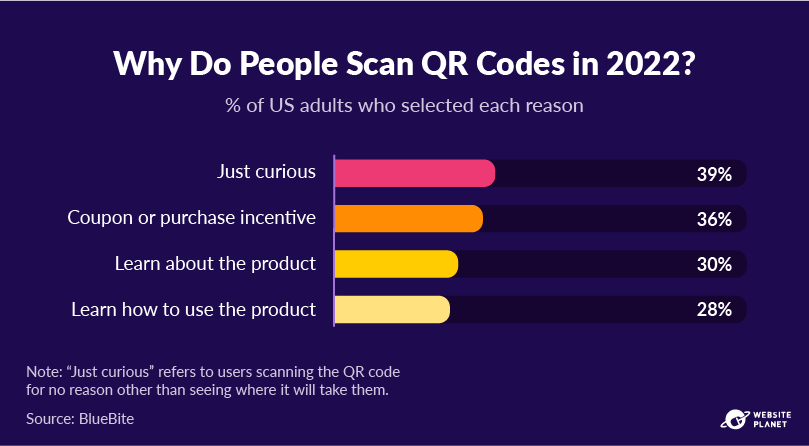
QR codes provide another channel for interaction between brands and customers. Their ease of use has meant that advertisers and event organizers have begun to adopt them in marketing campaigns and for educational purposes, placing codes on billboards, posters, informational materials, and in product manuals.
Some QR campaigns have also used guerrilla marketing to ‘invade’ public spaces with QR codes located in unusual but easy-to-notice places. Increased consumer understanding of what these codes can be used for drives curiosity around the objects, which translates to more scans for these types of campaigns.
#6 People in the US Are Bullish on QR Codes

People in the US are increasingly using QR codes. Nearly 60% of surveyed US consumers say that they see this technology becoming a permanent part of their lives.
This projected growth is thanks to the increased availability of free QR code generators and the inclusion of built-in scanners in most new smartphones. With their increased use by US companies for marketing and events, it should come as no surprise that most US respondents feel QR codes are here to stay.
#7 Most Smartphones Have Built-In QR Code Scanners

Although the first mobile phone that was able to scan QR codes was released in 2002, this capability didn’t become a mainstay in mobile devices until the late 2010s.
It was only in 2018, after Apple had introduced a built-in scanner for iPhones and Android 9.0 did the same for other devices, that many users no longer had to rely on third-party apps to scan QR codes.
Today, 91% of iOS users have iPhones released after 2017, which all come with a native QR scanner. Plus, 86% of all Android users have operating system 9.0 or higher, which has a pre-installed QR scanner in the form of the Google Lens application.
#8 Millions of US Users Scan QR Codes

QR code scanners have been rising in popularity in the US in recent years. The number of smartphone users who used a QR code scanner jumped by almost 20 million between 2020 and 2022. After reaching 88.9 million users in 2022, the technology is projected to hit 94.1 million users by the end of 2023 and exceed 100 million by the close of 2025.
It’s important to note that only adults were included in the study. Had teenagers also been considered, these numbers would likely have been much higher.
#9 Marketing QR Code Users Skew Young

While young adults (aged 18–29) are the most likely to scan marketing-related QR codes in the US, the age distribution of marketing QR users is fairly even. This speaks to the ease of use of QR codes compared to other tech tools.
Nearly half of 30–44-year-old consumers claimed that they used a marketing QR code in the three months prior to the survey, as did 44% of those aged 45–64. Even 31% of consumers 65 and over have reported having used QR codes in the same timeframe.
Section 2: QR Codes Use by Industry
Initially developed for automotive manufacturers, QR codes have also proven to be beneficial for other industries. Nowadays, they’re being used in restaurants, on food packaging, and in the aviation industry, among others, and have a significant impact on how these sectors operate.
#10 Restaurants Adopt QR Codes at a Fast Rate

The restaurant industry has been quick to turn to QR technologies to save money and paper – and reduce contact – by providing codes that guests can scan to view menus, place orders, and pay for meals.
According to recent data, 7 out of 10 US-based eateries use QR codes. Plus, 58% of US adults claim they prefer to access menus on their phones.
#11 More than Half of QR Codes Direct Users to PDF Files

After URL access, file downloads are the second most popular use case of QR codes and restaurants are a major driving force behind this trend. The objects allow for the quick, convenient way to download and view menus in a contactless way – an application that accounts for 53.1% of all QR code usage in restaurants.
In addition to offering digital menus, restaurants also use QR codes in other ways. For example, to redirect customers to various landing pages that contain marketing materials or a restaurant’s opening hours, address, or social media profiles.
#12 QR Codes on Food Packaging

QR codes on food packaging have a number of uses. Although the majority of Canadian consumers scan them to get more detailed information about the products they’re buying, the objects can also be used to display ads or simply redirect users to the producer’s website. Some brands, however, are using them in increasingly inventive ways.
Many food manufacturers hide sweepstakes and other contests behind scannable codes, as well as on more traditional marketing materials. For example, Ecuador’s Ministry of Tourism drove a QR code campaign where the matrices were placed on the labels of export bananas. When consumers scanned the code, they would be taken to a promotional video and website that encouraged them to visit Ecuador.
#13 QR Codes Are on the Rise in Banking

Globally, QR code adoption at national banks rose by 32% in 2021. Banks are increasingly using the technology because it is a secure, easy-to-use alternative to other authentication methods.
For example, South African bank Capitec launched Capitec Pay Me, a QR-based solution, in late 2021. This facility allows customers to generate personalized QR codes to receive immediate payments from other Capitec customers. Within one week of its launch, 2.5 million clients had activated the service.
#14 Charities Use QR Codes for Contactless Donations
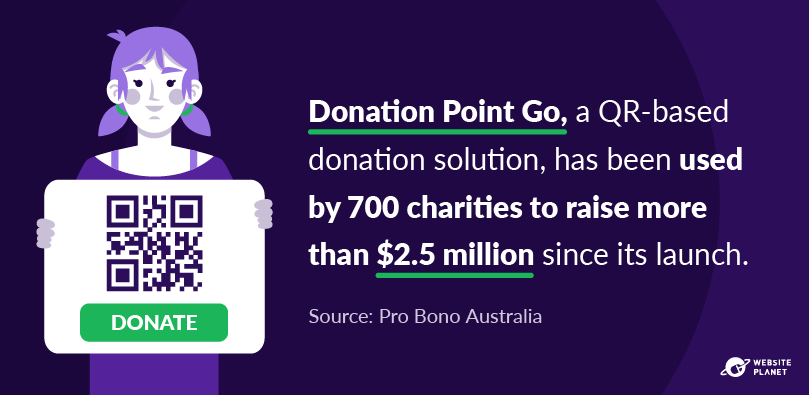
COVID-19 impacted many charities around the world, which relied on face-to-face collections for the lion’s share of their donations. Despite the initial increase in donated funds at the start of the pandemic, donations have dipped in the following months.
Fortunately, the marketability of QR codes and their ability to be placed almost anywhere helped charities to overcome this problem. QR codes can be used to direct donors to donation pages where they can easily input their payment information, removing much of the friction usually associated with one-time donations.
In Australia, Donation Point Go’s Donation Point Tap service has allowed 700 charities to raise more than 4 million Australian dollars (equivalent to over 2.5 million US dollars) since its launch. These QR codes are used in creative ways, such as being displayed on volunteers’ t-shirts or badges.
#15 QR Codes Simplify Check-Ins and Reservations at Hotels
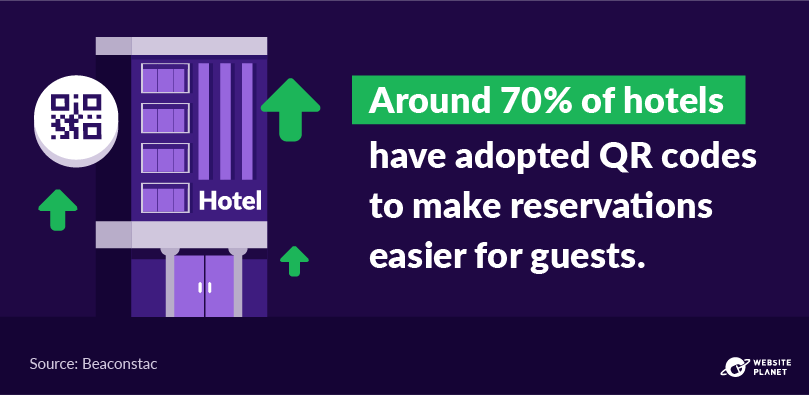
Hotels can use QR codes to improve their customers’ and employees’ experiences. According to the Washington Hospitality Association, around 70% of them have deployed this solution for reservations.
For guests, the smart objects help them to save time when verifying their booking. Hotel staff can then provide guests with a QR code to easily access electronic registration forms. This reduces the need for paperwork and time spent manually inputting data.
Hotels also use QR codes to provide travelers with contact details for various services and information regarding nearby points of interest.
#16 Brands Have Jumped on the QR Trend

To avoid spreading COVID-19, many brands that relied on customers visiting their establishments (e.g. fast-food companies) had to find innovative ways to reach customers in a touchless manner.
Campaigns often encouraged users to scan a QR code that would redirect them to the company’s website or to a quick survey in exchange for freebies or discount offers. Burger King, for example, included floating QR codes in its TV adverts. Those who managed to capture the code would receive a free Whopper with their next order.
These incentives proved to be quite effective, with 45% of US shoppers having scanned a marketing QR code in the first half of 2021.
#17 QR Codes in Marketing Drive Engagement and Brand Awareness

Brands use QR codes in their marketing materials to create new avenues of interacting with consumers. Rather than simply having potential customers passively view TV, billboard, or online adverts, QR codes encourage viewers to actively engage with these messages.
For example, Vincle, a high-tech software vendor, displayed its QR codes at a variety of events, resulting in a 90% increase in engagement. Another example is Japanese online payment service PayPay, which signed up 15 million customers in 10 months through QR-based sign-up links.
Many Fortune 500 companies, such as Nike, Google, and Amazon, have also jumped on the QR trend to drive engagement.
#18 Audiences Are Split on QR Codes in TV Ads
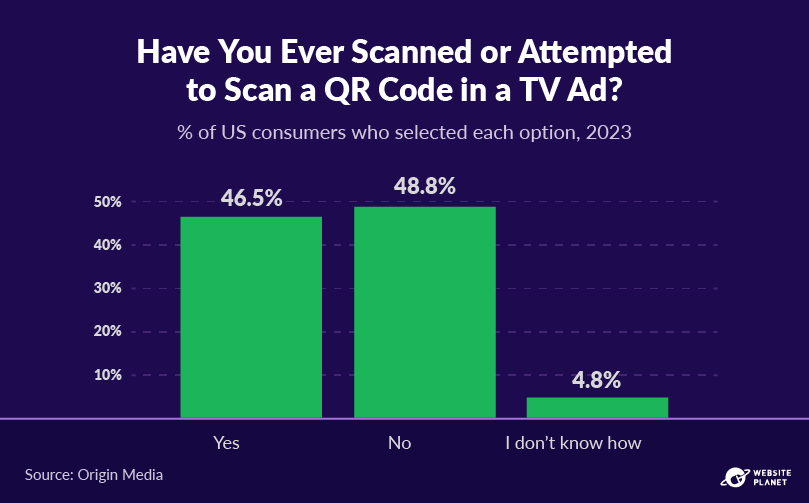
When asked whether they had ever scanned QR codes displayed in TV advertisements, US consumers were relatively evenly split between those who had and hadn’t. Interestingly, nearly 5% of respondents said that they didn’t know how to scan QR codes.
#19 QR Codes Are a Must-Have for Ecommerce in Asia

QR codes were invented in Asia and, in countries like China and Singapore, they have been the most popular form of contactless payments for years. This lies in stark contrast to the US and EU nations, where QR solutions have only recently become widespread.
Western companies that want to expand their business activities to Asian markets need to implement QR codes to be able to reach their sales targets. According to Chuck Huang, CEO of global payment integration platform Citron, businesses that don’t do this stand to lose 80% of their Asian target audience.
#20 Convenience Drives the Growth of QR Payments

When looking at the main drivers of QR payment usage, a clear pattern emerges: customers value the convenience and security that this payment method brings.
Scanning QR codes bypasses the need to carry around cash or credit cards, which are often easy targets for pickpockets. QR codes are also very simple and, with modern smartphones, users need only their device’s camera and an internet connection to make a payment.
Section 3: QR Code Usage around the World
Even though QR code usage is rising around the world, they’re not equally popular on every continent. This section provides insights into how QR codes are used and encouraged around the globe.
#21 A Large Number of Internet Users Scan QR Codes Every Month

As of 2023, 44.6% of internet users had scanned a QR code at least once. The country-by-country breakdown also reveals that QR codes are used more frequently in Asia than elsewhere.
Hong Kong claims the top spot, with 59.1% of survey respondents from the nation having recently used a QR code. Taiwan, China, Thailand, Singapore, and Malaysia don’t lag too far behind, with 56.1%, 55.6%, 54.1%, 51%, and 50.8% of respondents from these countries having done the same, respectively.
Western economic powerhouses such as the US, UK, and Canada are placed closer to the bottom of the list. These three countries sit well below the global average, with between just 28% and 33% of respondents scanning QR codes.
#22 QR Adoption Is Increasing in France

Although the use of QR codes is on the rise in France, adoption rates are still low compared to China and Southeast Asian countries. Still, the 4% increase in daily use over a six-month period shows that the French population is becoming aware of the potential of QR codes.
#23 Use of QR Codes Is Growing in India

In India, QR codes are becoming the preferred method of digitizing authorization, verification, and payment processes across a number of industries. As of 2021, 40% of the country’s population had used these smart objects to make a payment.
In 2020, the Reserve Bank of India announced that merchants across the country would be required to accept QR code payments. Furthermore, in 2022, the government mandated that all products with active pharmaceutical ingredients need to have a QR code affixed to them for verification purposes.
#24 QR Codes Are the Norm in China

QR codes were ubiquitous in China long before they broke into the mainstream in other countries. Over 100 million scans were registered in October 2013 in China, which shows the scale of the implementation of this technology.
The digitalization of everyday activities in China is more advanced than in other parts of the world, and much of it is driven by QR codes. Popular “super-apps” like WeChat and AliPay have built-in QR scanners, and are also capable of generating codes for public transport tickets, payments, and other verification mechanisms.
#25 Southeast Asia Leads QR Payment Adoption

With 69% of surveyed Southeast Asian consumers interested in using QR payments in the future, it’s expected that the overall usage in this part of the world will grow beyond the current 34%.
According to data from Visa, Malaysia, Thailand, Vietnam, Indonesia, and the Philippines are the five countries where QR code usage is most prevalent. Here, the convenience and safety of not having to carry cash and cards are the biggest motivation for QR code payment adoption.
#26 QR Code Use Is Still Relatively Low in Japan
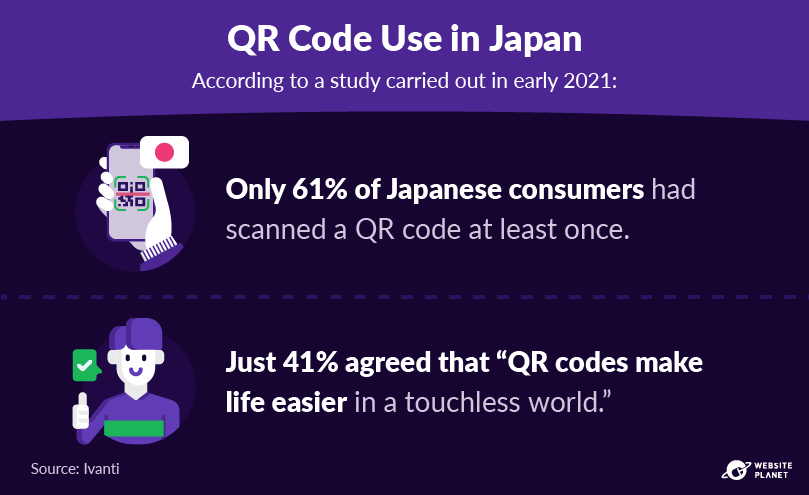
Despite being invented in Japan nearly 30 years earlier, 39% of Japanese consumers surveyed in 2021 had never scanned a QR code.
Only 41% of surveyed individuals agreed that QR codes simplify life in a touchless world. Businesses and individuals in Japan have opted for other contactless methods, such as tap-and-go credit card payments, digital wallets, and bank transfers.
#27 QR Code Adoption Is Rising in Latin America

Over 110 million QR code payments were executed across the continent in the second half of 2022 using Mercado Pago, a leading digital banking solution provider in Latin America.
These numbers represent a nearly 150% increase in usage compared to the same period in 2021, suggesting that QR codes are quickly gaining popularity as the preferred contactless payment method in the region.
Section 4: The Impact of COVID-19
The COVID-19 pandemic was a major driver of growth for QR codes. As more and more of our activities started taking place in the digital sphere, QR codes became one of the go-to ways for businesses to interact with customers, and for public health officials to reliably track COVID-19 cases.
#28 QR Code Downloads Went through a Huge Boom during the Pandemic

Between the first quarter of 2020 and the last quarter of 2021, downloads triggered by QR codes saw a 750% increase.
At hotels, QR codes were most often used to prompt guests to download check-in forms and guides, while many restaurants provided their guests with downloadable PDF menus. Other industries also caught on, with file sharing via QR codes becoming widespread in areas such as marketing and charity work.
#29 QR Code-Related Search Volume Has Risen during the Pandemic

QR codes were never Googled as frequently as they were during the pandemic. Once it became clear that most businesses would need contactless ways of interacting with their customers, interest in QR codes saw consistent growth.
Some of the most popular QR-related search terms Googled during the pandemic included “health QR codes” and “QR menu.”
#30 People’s Willingness to Use QR Codes Remained High during the Pandemic

While brands and public officials pushed the use of QR codes in a variety of settings, ordinary people have proven to be equally as eager to use the technology.
This is especially true at venues like hotels, medical offices, museums, music venues, and others that would normally require some degree of physical contact between patrons and employees. About half of the general population have also expressed a willingness to keep using QR codes post-pandemic.
#31 EU COVID-19 Vaccination Certificates Are Verifiable via QR Codes

Once COVID-19 vaccines became available in Europe, most establishments and border authorities required customers and travelers to have a valid vaccination certificate in order to move around freely.
QR codes were a convenient way to verify travelers’ vaccination status as authorities were able to see it by simply scanning their vaccination certificate.
#32 COVID-19 Made US Restaurants Pivot to QR-Based Menus

As restaurants were forced to adapt to social distancing requirements and restrictions aimed at curbing the spread of COVID-19, paperless menus turned out to be a lifesaver for many business owners.
In the US, 52% of restaurants adopted this solution after being allowed to open up with certain limitations. Aside from simple PDF downloads, some QR-based menus enabled customers to order directly via their smartphone, further limiting waiter interactions.
#33 QR Payments Grew during COVID-19 in Asia

Consumers in China and Southeast Asian nations were adopting QR payment options even before COVID-19 broke out, but the pandemic accelerated this trend. In Thailand, for example, the percentage of people who regularly used QR codes to pay for things grew from 23% pre-pandemic to 63% in May 2021.
It’s important to note that in most countries in Asia, COVID-19 guidelines were much stricter than in Western nations. This increased the need for fast, convenient, and contactless payments, with QR codes often being the most obvious choice to meet this need.
Section 5: QR Code Risks and Challenges
QR codes are convenient, easy to use, and free to set up, but they are not risk-free. Cyber criminals are increasingly using these smart objects to carry out their scams, so it’s important to be aware of the major security flaws posed by QR codes.
#34 People Are Unaware of What QR Codes Can Do

While they’re a great piece of technology that can make our day-to-day lives easier, the lack of general awareness of QR codes’ capabilities creates major cybersecurity risks. One of the main reasons for this is because there is no way of distinguishing legitimate codes from malicious ones with the naked eye.
More than half of international respondents in software company Ivanti’s survey didn’t know that QR codes can download apps and open URLs. Cyber criminals can take advantage of this lack of general awareness to gain access to victims’ devices.
Improving people’s knowledge about this technology is one of the main challenges that needs to be overcome in order to make QR codes cyber risk-free for everybody. Users should be wary of smart objects that look to have been tampered with, or those that unexpectedly request payments or personal information upon scanning.
#35 Many People Can’t Identify Malicious QR Codes

Some QR codes can wreak havoc on people’s devices. For example, they can be used to automatically download a file that contains a virus, gathers personal data, or initiates unwanted payments.
With the number of people able to identify malicious QR codes being 20% lower than those who can spot a fake URL, security systems may need to be created to help consumers make more informed choices.
#36 Why People Refrain from Scanning QR Codes in TV Adverts
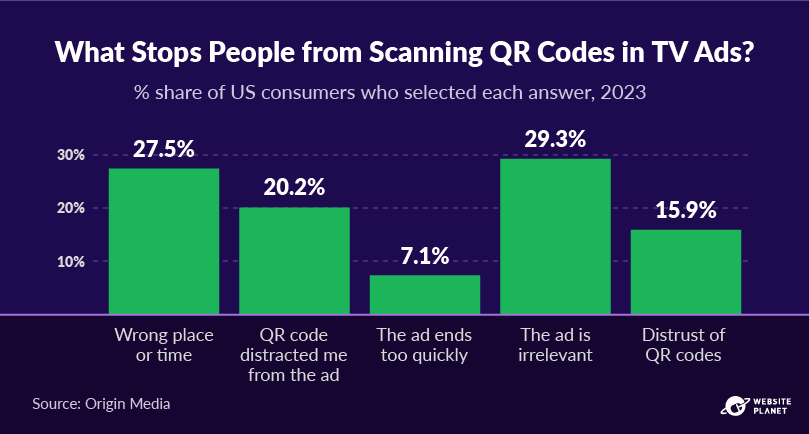
A survey carried out among US consumers revealed some of the main reasons why people are reluctant to scan QR codes displayed in ads when watching TV. Their answers highlight some of the key challenges marketers need to overcome when displaying QR codes in advertisements.
What stands out here is the fact that one-fifth of respondents stated that the QR code distracts them from the ad itself, highlighting a major issue with how QR codes are used in TV advertisements.
In order to make QR codes more effective on TV, marketers may consider making them the main focus of the ad or displaying them only after viewers have had the chance to view the content first.
#37 QR Scams in the Crypto Sphere

Cryptocurrency wallets make use of QR codes to trigger transactions without having to type in the wallet ID. Cybercriminals took note of this, and in recent years, many sites posing as Bitcoin wallet QR code generators have scammed people out of thousands of dollars worth of cryptocurrencies.
This, like many other cybersecurity issues, would not have been possible if people were more informed about the technology they’re using to invest their money. Most crypto wallets allow users to generate QR codes in-app, which means that there is no need for these generator websites to exist at all.
#38 Many German Users Have Scanned Suspicious QR Codes

Distinguishing malicious QR codes from genuine ones can be difficult. Scammers can easily sneak their own codes into public spaces, posing as street advertisements or restaurant menu codes.
Over one-third of German consumers have been led astray by a QR code they scanned. This is despite the fact that 51% of respondents in Germany claimed that they were able to recognize a malicious code, going to show just how easy it is to trick someone into scanning a suspicious QR code.
#39 The Majority of Brits Are Unaware of QR Code Spam
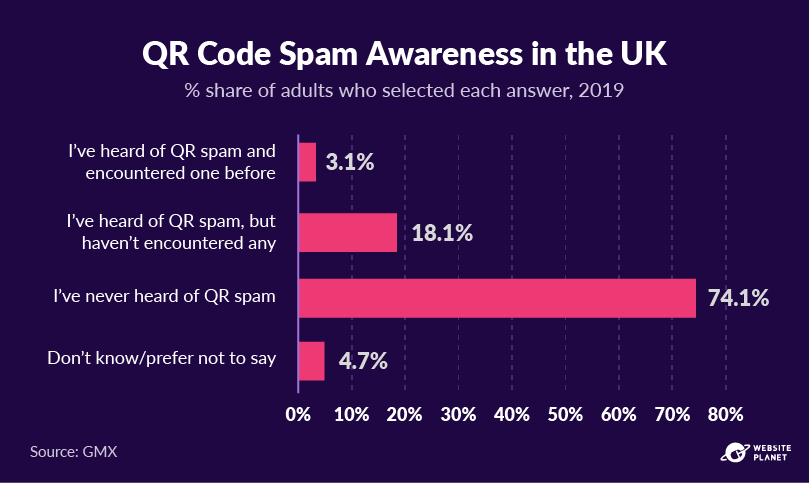
Phishing is usually associated with clickable URLs, but QR code phishing is the next iteration of such schemes. Spam messages containing QR codes can redirect users to phishing sites upon scanning. This, in turn, leads to their data being harvested by identity thieves and sold to cyber criminals.
Worryingly, most surveyed UK adults have never heard of this type of cybercrime.
#40 Chinese Citizens Are Concerned about Mobile Payment Security

In a mobile payment survey carried out by the Payment & Clearing Association of China in 2020, four out of five Chinese respondents said that they were concerned about what happens to their personal information after making payments using their smartphones.
Considering how popular QR codes are for paying for goods and services over the internet in China, this sentiment highlights a need for implementing more security measures in QR-based payment systems.
#41 QR Codes Account for the Majority of Mobile Payment Fraud in China

QR codes are used more frequently than near-field communication (NFC) and contactless payment cards in China. So, it should come as no surprise that they’re a target for fraud.
The vast majority of people were scammed for less than 100 yuan, or $16. These small amounts of money usually don’t require additional authorization and can be obtained without arousing suspicion. They can add up to quite a fortune, though; in Guangdong province alone, $13 million was stolen by way of QR scams, according to data from 2017.
Section 6: The Future of QR Codes
Few payments experts, business owners, or even tech enthusiasts could have predicted the rapid increase in usage and popularity that QR codes have seen in recent years. Now that they’ve fully entered the mainstream, the future looks bright for these scannable matrices.
#42 Future Market Value of the QR Code Payment Market

With COVID-19 having given the QR code industry a boost, the codes are not expected to go away anytime soon. Many industries have woken up to the efficiency and convenience of these smart objects, especially in the digital payment sphere.
According to Grand View Research’s forecasts, the market value of QR code payments will grow at an annual rate of 16.9% over the remainder of the decade, reaching $33.13 billion in 2030.
#43 The Future of QR Codes in the US

According to recent data from The Drum and YouGov, the vast majority of US adults say that they would be willing to use more QR codes in the future.
This sentiment was strongest among respondents aged 18–44, with 82% saying that QR solutions will become a “permanent part of using their phone.” Those older than 45 were slightly less confident about QR codes remaining relevant in the coming years. That said, 64% of that age group are willing to use them in the future.
#44 QR Smart Packaging Will Become More Popular

Consumers are demanding more transparency on food labels, and smart packaging enabled by QR codes may be one of the best ways to meet their expectations. It allows manufacturers to include exhaustive information about products without having to print this directly on packaging.
This is a large part of the reason that the smart packaging market’s revenue is projected to grow to $8.6 billion by the end of 2025.
#45 QR Code Payments Will Attract Hundreds of Millions of New Consumers by 2025

The global usage of QR code payments is expected to surpass 2 billion users around the globe by 2025. PYMNTS cites their ease of use, convenience, and efficiency as the main growth drivers for this technology.
Most of the growth is expected to come from emerging markets, with the West being slower to adopt QR codes due to the popularity of other contactless payment methods. Another reason for the slow uptake is caution, driven by privacy and cybersecurity concerns around QR codes.
#46 The Number of QR-Scanning Individuals Will Increase

With big brands increasingly using QR code technology in their marketing campaigns, the convenience of contactless payments, and the adoption of these smart objects by various industries means that QR codes have become part of our daily lives.
Furthermore, more consumers will use smartphones with built-in scanners, lowering the barrier to entry for this technology for most people.
#47 Most Commercial Activity Will Become Contactless by 2024

Gartner predicts that 80% of “ordering and replenishment” activity (i.e. reordering items to meet demand) will be contactless by 2024. This falls in line with the ongoing trend toward the increased adoption of touchless solutions.
QR codes are already a key part of business-to-business transactions, used to track shipments, verify products, and increase sales through marketing campaigns. Consumers, on the other hand, use them to trigger payments, confirm orders, and make use of discounts. Thus, the continued rise in contactless commerce could facilitate the further growth of QR codes in the coming years.
The Bottom Line
The effect of the COVID-19 pandemic and the consequent need for contactless modes of payments and interactions cannot be understated in the rapid adoption of QR codes. But, as many forecasts are suggesting, this technology looks set to remain relevant for years to come.
The majority of growth in the QR industry will be facilitated by emerging markets, where QR codes are already becoming major drivers of easy, swift financial inclusion. In the West, QR codes’ utility for marketing, advertising, and information sharing will likely be the biggest drivers of growth.
Considering the potential of this clever piece of technology, it’s essential that governments, business owners, and consumers alike understand the capabilities and potential challenges of QR codes.

















